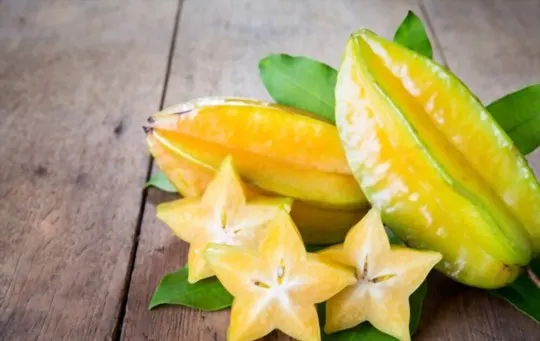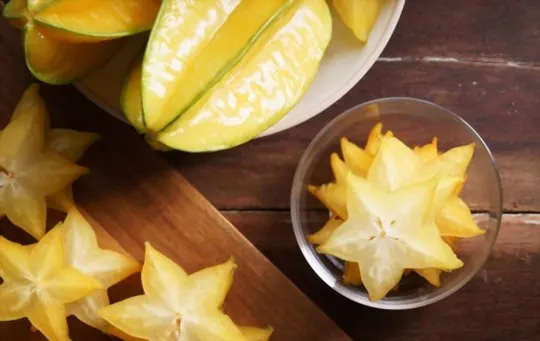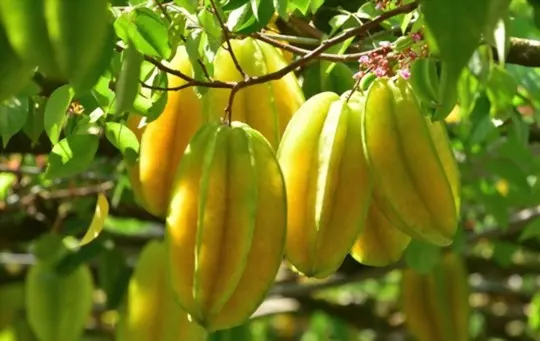Are you curious about star fruit? Do you want to know what it tastes like and how to pick the best one? You’re in luck.
In this article, we will answer all your questions about star fruits and provide tips for choosing and eating them.
Discover all the secrets of this sweet, tangy fruit today.
What is a Star Fruit?

Star fruit, also known as carambola, is a tropical fruit that gets its name from its distinctive star-like shape when sliced.
The fruit is popular in Southeast Asia, the Caribbean, and Latin America and has a sweet and tart flavor with a firm and crunchy texture.
Star fruit is versatile and can be eaten raw or used in dishes such as salads, juice, and even as a garnish for cocktails.
The flavor profile is often described as a cross between a grape, apple, and citrus fruit.
It is a rich source of Vitamin C, fiber, and antioxidants.
However, people with kidney problems or taking medication should consult their doctor before consuming star fruit due to its high levels of oxalic acid.
What Does a Star Fruit Taste Like?

Star fruit, also known as carambola, is a tropical fruit with a unique star shape and a flavor profile that is a cross between citrus, apple, and pear.
Its flesh is juicy, crispy, and slightly tangy.
The texture is similar to a grape, and it has a mild, sweet flavor with a slightly sour undertone.
The taste of star fruit varies depending on its ripeness.
A ripe star fruit has a yellowish-green hue and a sweeter flavor profile, while an unripe one has a green color and a sour flavor.
Star fruit can be eaten raw, cooked, or juiced, and it makes a great addition to fruit salads, smoothies, and desserts.
Its unique shape also makes it a fun and decorative addition to fruit platters.
Factors that Affect the Taste of Star Fruit

Star fruit, also known as carambola, is a tropical fruit that derives its name from its distinct shape when it is cut crosswise.
The taste of star fruit can be influenced by several factors which include:
- Maturity: Star fruits that are fully ripe have a sweet and tangy taste, whereas immature fruits taste sour and unpleasant.
- Variety: Different varieties of star fruit have distinct flavors. Some have a mild flavor with a hint of sourness, while others have a more complex flavor profile that is sweet, tangy, and slightly acidic.
- Growing conditions: The taste of star fruit can be affected by where it’s grown. Star fruits grown in fertile soil and a warm climate generally have a sweeter, more flavorful taste than those grown in colder climates.
- Firmness: The texture of a star fruit can also affect its taste. Ripe fruits are firm but slightly soft to the touch, while overripe fruits are mushy and have a bland taste.
- Season: Star fruits that are in season usually have a more intense flavor compared to off-season fruits.
Overall, the taste of star fruit is unique, mildly sweet, and tangy.
It has a juicy, crispy texture that makes it a great addition to salads, desserts, and juices.
Pro tip: To enjoy the best flavor, it is best to consume fully ripe star fruits that are slightly soft to the touch.
1 – Ripeness
Star fruit, also known as carambola, is a tropical fruit native to Southeast Asia and has a unique star shape.
The fruit is consumed when it’s fully ripe, turning yellow with brown ridges that run down from the five prominent edges of the fruit, indicating its readiness for consumption.
When the fruit is immature, it can taste tart and sour, but when it’s fully ripe, it has a sweeter and milder flavor similar to a combination of citrus, apple, and grape.
Star fruit is incredibly juicy and refreshing with edible seeds and a thin, waxy skin.
Its distinct, unique taste makes it an ideal ingredient for use in salads, refreshing beverages, and as a garnish for cocktails.
Pro Tip: Choose a fully ripe and fresh star fruit for the best taste and flavor experience.
2 – Variety
Star fruit, also known as carambola, is a small tropical fruit with a unique shape and flavor.
The taste of a star fruit depends on its ripeness.
An unripe star fruit has a tart, slightly sour taste and a crisp texture, similar to green apples.
As it ripens, the taste becomes sweeter and juicier, with a flavor profile that combines notes of pineapple, citrus, and kiwi.
The texture of a fully ripe star fruit is soft and slightly crunchy, with a translucent flesh and edible seeds.
It is a versatile fruit that can be eaten fresh as a snack, used in salads, or as a garnish for cocktails and desserts.
Pro tip: When selecting a star fruit, look for firm fruit without any blemishes or soft spots, as they tend to spoil quickly.
3 – Growing Conditions
Star fruit, also known as carambola, is a tropical fruit that grows best in warm and humid conditions.
The tree thrives in full sun and well-drained soil with a pH level between 5.0 and 6.5.
The fruit has a unique flavor that is often described as tart, tangy, and sweet.
The texture is crispy and juicy, similar to a grape or a pear.
Depending on the maturity level, the fruit can taste more sour or sweet.
Some people compare the taste to a combination of apple, grape, and citrus.
When selecting star fruit, it is best to choose fruit that is firm, yellow, and free of blemishes or bruises.
It can be eaten raw or cooked and is often used in salads, drinks, and desserts.
Pro tip: To bring out the flavor, sprinkle some sugar on sliced star fruit or add it to a fruit salad.
Culinary Uses of Star Fruit

Star fruit, also known as carambola, is a tropical fruit with a distinct star shape and a crunchy texture.
It is widely used in culinary arts for its unique flavor that is a blend of tart and sweet with a hint of citrus.
Here are some popular culinary uses of star fruit:
- It is commonly eaten fresh as a snack or added to fruit salads for a tangy flavor.
- Star fruit can be used to make juices, smoothies, and cocktails for a refreshing tropical twist.
- It is also used in savory dishes like stir-fries and curries to add a tangy flavor to the recipe.
- Star fruit is widely used to make jams, jellies, and chutneys for a sweet and tangy spread.
- It is sometimes even used to garnish desserts and pastries for a unique and flavorful touch.
How to Choose and Store Star Fruit?

Star fruit is a tropical fruit that is gaining popularity around the world for its unique shape and flavor.
Its taste is a mix of sweet and tart, and similarly, it has a flavor that is often described as a cross between citrus, apple, and grape.
Choosing and storing this fruit is easy, just follow these simple steps:
- Look for star fruit that is bright yellow in color, has a smooth texture, and feels heavy for its size.
- Avoid overripe fruit with brown spots or mushy texture.
- To store star fruit, wrap it in a paper towel and place it in a perforated plastic bag in the refrigerator; it will last for up to a week.
- To use star fruit, rinse it, slice it crosswise, and remove any seeds before eating. Star fruit can be eaten raw, used in smoothies, salads, or as a garnish for cocktails.
Star fruit contains oxalic acid, which can cause kidney damage in people with kidney disease, so if you have any kidney problems or are on medication, consult with your doctor before eating this fruit.
Conclusion
In conclusion, Star Fruit, also known as Carambola, is a tropical fruit with a unique star-shaped appearance and a sweet and tangy flavor.
This fruit is rich in vitamin C, fiber, and antioxidants, making it a healthy addition to your diet.
When ripe, the fruit is yellow with ridges that form the shape of a star, and its flesh is juicy and crunchy.
Its flavor is a combination of sweet and tart, similar to a blend of citrus fruits such as lemons and pineapples.

What Does a Star Fruit Taste Like? A Comprehensive Guide
Ingredients
- Star fruit
- Ingredients from your selected recipes
Instructions
- Select ingredients that work well together.
- Use a recipe or method that will enhance their natural taste.
- Taste and adjust the recipe as needed to achieve the desired flavor.

Carrie is a food writer and editor with more than 15 years of experience. She has worked for some of the biggest names in the food industry, including Bon Appétit, Food & Wine, and Martha Stewart Living.
As the Editor in Chief of IntroChicago.com, Carrie oversees all of the content on the site. She also manages the team of contributing writers and editors, who help to create delicious recipes, helpful tips, and informative articles that you’ll find on the site.
A native of the Chicago area, Carrie is passionate about all things food. She loves trying new restaurants and experimenting with new recipes in her kitchen. She’s also a graduate of the Culinary Institute of America, so she knows a thing or two about food!
